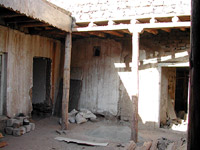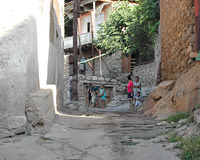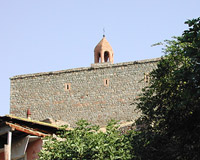
Turning Meghri into a Tourist Destination
Meghri is the southernmost region of Armenia. It borders Zangelan on the east and Nakhichevan on the west. Its neighbor to the south is Iran; the border passes along the length of the Arax River. Although Meghri is not large in area - only 644 square kilometers - it encompasses almost every climatic zone, from dry tropics to alpine plains. Residential areas are spread out over altitudes ranging from 600 to 2000 meters above sea level.
The region has a population of 12,200, some of which - mainly those in the city of Agarak - work in the local molybdenum and copper refining plant. Others work in agriculture, especially in growing crops and fruits. Meghri is renowned for its pomegranates, figs and pineapples.
As of the end of the last century, there were 65 monuments registered in the Meghri region, remarkable for their architectural style and for the murals that are rarely seen in Armenian churches or monasteries. The churches in the old and new sections of the city of Meghri bear the intricate inscriptions of artists of the Hovnatanyan family.
 |
 |
 |
 |
In 2000, a project aimed at preserving the unique architecture, lifestyle and cultural traditions of Meghri, entitled "Repairing the economy in the southernmost region of Armenia", was presented to UNESCO. It was approved and included in the 2001 Culture for Development donor conference.
Architect Armine Petrosyan is the initiator of the project and founder of Meghri-1, a non-governmental organization that implements important programs in the region, aimed not so much at turning Meghri into a museum, but at restoring and exploiting the region's living cultural heritage. Petrosyan believes it is especially important to preserve the traditional ethnic environment of the region.
To this end, Meghri-1 has been restoring traditional houses in the old section of town, in the hopes of promoting tourism in the region. Meghri's City Hall also has a major role to play in this program; Mayor Misha Hovhanissyan is a member of Meghri-1 and is doing everything in his power to support the organization's programs. Financial support for the restoration of the first house in the old section of Meghri has come from the Swiss-Armenian Izmirlian Foundation.
"We presented the whole project to the Izmirlian Foundation two years ago. The executive director of the foundation, Jacques Sargsyan, got things going," Petrosyan explained.
In order to convince anyone to set up a project in Meghri, you have to go into long-winded explanations about what Meghri is, where it is, and why people should invest in Meghri instead of anywhere else. Because it is so remote, Meghri is literally beyond most people's field of vision. In Soviet times, people had to have special permission from internal affairs to visit the area. Passengers on the train to Meghri, which passed through Nakhichevan, or the bus-the shortest route was once again through Nakhichevan-were subjected to numerous and extensive checks. If it hadn't been for the vibrant and indelible impression left by the Meghri landscape, people would not likely have endured those dealings with the police and border patrol.
Armenia is, in general, a collection of amazing landscapes - Yeghegnadzor is nothing like Lori, Aragatsotn and the Sevan basin are extremely different, even neighboring Sisian and Goris have little in common. Meghri is a compact version of all of this. You can see everything here-if it's the desire to see all of Armenia in one compact area that brings you to Armenia, you'll come again and again, against all odds.
Nevertheless, Meghri is not included in the packages offered by all the various tourism agencies. This is, of course, largely due to how far away it is, but the lack of hotels and guest houses is also a factor.
The program that Meghri-1 is implementing aims at developing the tourism infrastructure in this region. The first step is to restore the traditional home ambience.
Restoring a house, or even all the houses in one part of town, will not accomplish that objective if the people's attitude does not change. "Basically, everything has to develop together - the houses, people, environment, everything... even plants - trees and flowers - everything has to develop together so that nothing seems artificial or out of place," said Armine Petrosyan.
The architect feels that people did not consider this much of a problem in the past. People would build houses, plant trees next to them, and, without any particular design skills, everything fell together in harmony and became a part of their environment. The tourists who visit Meghri in the future will also get to consider themselves a part of this environment.
Imagine this - you stay in Meghri for two days, but you do not stay at some hotel, but at the home of an ordinary person, who offers you the fruits of his garden to eat, the bounties of his cellar to drink, and tells you tales of his ancestors who lived in your room years ago.
Armine Petrosyan feels that in order for this to happen the people of Meghri must first be convinced that their old town is not just the place where they live, but a place where people, lifestyle, and culture are inseparable.
"I want the attitude of people, in general and towards each house, to change after it is restored, so that they become a part of this environment too," Armine Petrosyan said.
Her concern is to restore the rural atmosphere in the area, something which has been accomplished long ago in many European countries, and which has long attracted tourists with its warm, honest hospitality. Tourists in Armenia mainly see the structures that represent our ancient culture - statues, museums, galleries and so on. They stay at so-called European standard hotels, whose European design and Arab-Iranian construction material do not leave a lasting impression.
Four years ago, I had the opportunity to stay at a house like this in the south of France. It had been built in 1828, but the facilities left nothing to be desired, even compared to the best hotels. When I visit France now, the first thing that comes to my mind is the two weeks that I spent at that old house, my kind and hospitable hosts, and the home-made pear vodka we used to drink every evening while we talked in many different languages all at once.
"To me, making wine is an example of culture. Drying fruits is culture as well. I think these are the values we should work on," said Armine Petrosyan, firm in her belief that distant Meghri will develop along this ideal and become a major Armenian tourist destination.
 Videos
Videos Photos
Photos
Write a comment